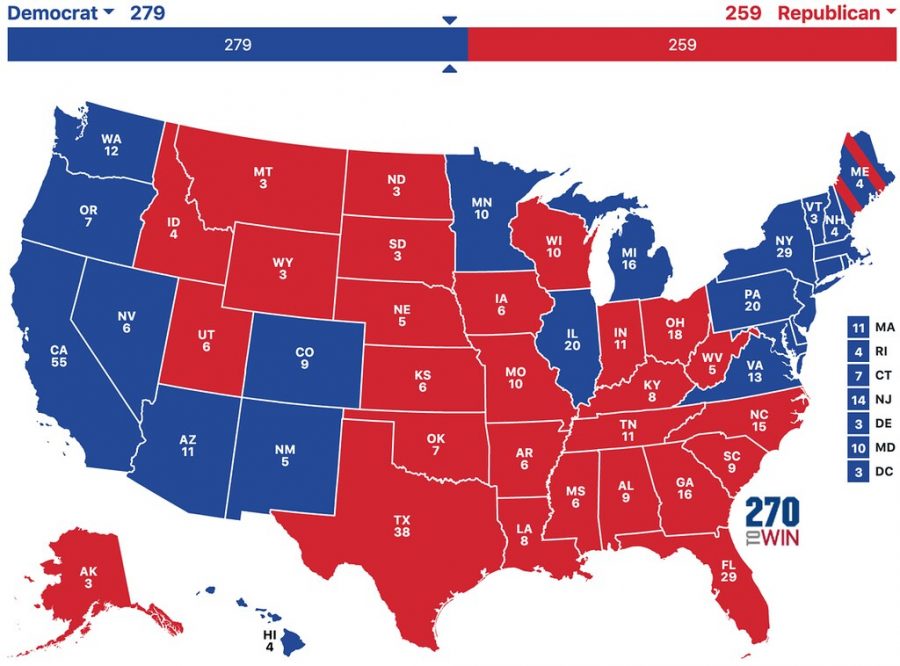Op-ed: The Electoral College is an erosion of American democracy
“2020 Presidential Election Interactive Map” by nordique is licensed under CC BY 2.0
The Electoral College is a unique feature of the American electoral system.
November 12, 2020
In response to President Donald J. Trump’s calls to “stop the count” of legally-casted mail-in ballots, protestors gathered in the streets of several U.S. cities, hoisting picket signs denouncing his administration and chanting “count every vote.” However, President Trump has not been the sole enemy of democracy throughout this grueling election cycle. The Electoral College has been undermining the right to free and fair elections for centuries.
The Electoral College was founded as a compromise between a nationwide popular vote and a congressional vote. This system hinges on the philosophy of representative democracy, with each state allotted a certain number of electors based on the number of senators and representatives serving in the state. The presidential candidate who wins the popular vote in the state receives all of its electoral votes, a “winner takes all” structure that erases the votes of millions of Americans.
In the 2016 presidential election, 4.5 million Californians voted for Trump, yet all 55 of California’s electoral votes went toward the state’s popular vote winner, Hillary Clinton. Similarly, 3.9 million Texans voted for Clinton, yet all 38 of Texas’s electoral votes went toward Trump. In total, 55 million Americans in the political minority of their state saw their votes disregarded under the Electoral College.
Votes are also disproportionately weighted state by state. In the nation’s most populated state, California, one electoral vote represents about 718,000 voters. In the least populated state, Wyoming, one electoral vote represents only 193,000 voters. A single vote in Wyoming holds almost four times the weight of a vote in California, despite the “one-person, one-vote” constitutional principle asserting that every vote is equal.
Furthermore, a vote cast in a “swing state” holds greater weight than a vote cast in a Democratic stronghold like Massachusetts or a Republican stronghold like Alabama. Coastal states in the West and Northeast are considered guaranteed wins for the Democratic party, while rural, southern states are considered guaranteed wins for the Republican party. As a result, the election often comes down to the decisions of voters in swing states such as Pennsylvania, Florida, Wisconsin and Michigan, which do not lean heavily Democrat or Republican.
Trump’s 2016 victory was contingent upon his 0.7 percent win in Pennsylvania, 0.3 percent win in Michigan and 0.7 percent win in Wisconsin. Though he lost the nationwide popular vote to Democratic opponent Hillary Clinton by 2.9 million votes, Trump won the presidency thanks to just 80,000 voters in these three states.
The events of the 2020 election seem all too familiar. President-elect Joe Biden won the popular vote by more than 4 million votes, yet throughout the electoral process, Trump maintained a very feasible pathway to victory in the Electoral College. Biden eventually secured his seat in the White House not through his clear popular vote majority, through just thousands of voters in Pennsylvania. The president should be elected by the majority of all Americans, not just by the majority of Americans in a select cohort of swing states.
The inherent flaws of the Electoral College boost voter turnout in certain states and suppress it in others. Voters in solidly red or blue states are less inclined to show up at the polls, guided by the conviction that the fate of their preferred political party is already determined. In swing states, on the other hand, voters participate at higher rates. Only 64.7% percent of eligible voters in largely Democratic California voted in the 2020 election, while 76.1% of eligible voters in toss-up state Wisconsin casted a vote.
So what is the benefit of an election process that discards votes, disproportionately represents voters, distorts turnout and delegates the ultimate decision to a handful of swing states? The answer is simple: the Electoral College enables the Republican Party to hold onto power in an increasingly Democratic society. Of the 2020 electorate, 44 percent leans Republican and 49 percent leans Democrat, and these numbers are expected to skew even more in favor of the Democrats in coming election cycles as the overwhelmingly liberal Generation Z reaches voting age. The current system subverts the nation’s Democratic majority by overrepresenting right-leaning states composed largely of white, non-college-educated voters and underrepresenting states with left-leaning urban populations.
To borrow a phrase from President Trump himself, the Electoral College is a “disaster for democracy.” If the United States wishes to continue calling itself a democracy, it must adopt a popular vote that weighs each vote equally and takes every American’s choice into account. We are a united nation, not a discrete collection of independent states, and we deserve a voting system that reflects the will of the United States as a whole.
Elena Plumb is a second-year journalism major. She can be reached at plumb.e@northeastern.edu.







